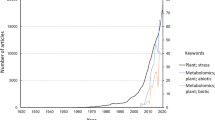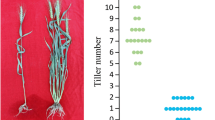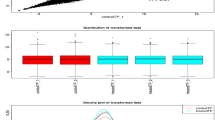Abstract
Background
Internal γ-Aminobutyric Acid (GABA) interacting with stress response substances may be involved in the regulation of differentially abundant proteins (DAPs) associated with optimum temperature and cold stress in tea plants (Camellia sinensis (L.) O. Kuntze).
Results
Tea plants supplied with or without 5.0 mM GABA were subjected to optimum or cold temperatures in this study. The increased GABA level induced by exogenous GABA altered levels of stress response substances – such as glutamate, polyamines and anthocyanins – in association with improved cold tolerance. Isobaric tags for relative and absolute quantification (iTRAQ) – based DAPs were found for protein metabolism and nucleotide metabolism, energy, amino acid transport and metabolism other biological processes, inorganic ion transport and metabolism, lipid metabolism, carbohydrate transport and metabolism, biosynthesis of secondary metabolites, antioxidant and stress defense.
Conclusions
The iTRAQ analysis could explain the GABA-induced physiological effects associated with cold tolerance in tea plants. Analysis of functional protein–protein networks further showed that alteration of endogenous GABA and stress response substances induced interactions among photosynthesis, amino acid biosynthesis, and carbon and nitrogen metabolism, and the corresponding differences could contribute to improved cold tolerance of tea plants.
Similar content being viewed by others
Background
Tea is one of the most popular non-alcoholic beverages all over the world, and tea plants (Camellia sinensis (L.) O. Kuntze) are one of the most vital commercial crops in many countries such as China, India, Sri Lanka and Kenya [1]. As an evergreen woody plant, tea is grown from tropical to subtropical areas. Tea plants continuously suffer from a wide variety of environmental stresses, including low temperature, which affects growth, survival and geographical distribution [2]. Cold stress can easily disturb photosynthesis process which is the most important process required for plant production [3, 4]. Intensive studies have explored the molecular, cellular and physiological events that regulate the growth of tea plants and differentiation under cold stress [5,6,7]. For genetic engineering and plant breeding, it is vital to understand the mechanism for regulating tea plants’ growth under cold stress. Extensive molecular and genetic studies have greatly contributed to help us understand how plants survive and grow at low temperature. Various genes and metabolic pathways have been identified that function in enhancing cold tolerance. Well-known stress tolerance mechanisms including damage to membranes, GABA accumulation and its signaling pathways leading to osmotic adjustment, and other mechanisms associated with various secondary messengers, GABA also leads to transcriptional and post-transcriptional regulation [5, 7, 8]. Numerous genes encoding transcription factors and other metabolites related to cold stress have been reported and used for genetic engineering of plants with enhanced cold tolerance [9, 10]. Genome-wide analysis through transcriptomics and proteomics has been employed to illuminate events of some molecular types in environmental stress reaction, and the tea tree genome was sequenced very recently [Full size image
GO and COG analyses of DAPs in response to exogenous GABA at normal and low temperature
The proteins corresponding to the identified peptides in tea plants exposed toT2/T1, T4/T1 and T4/T3 were annotated using Blast2GO according to the cell component, biological and molecular function. According to the molecular functions, the DAPs for T2/T1, T4/T1 and T4 /T3 were classified into nine functional categories. For T2/T1, the main functional categories were protein metabolism and nucleotide metabolism (25.3%), energy (30.9%), amino acid transport and metabolism and other biological processes (11.2%), carbohydrate transport and metabolism (7.9%) and antioxidant and stress defense (15.7%) (Fig. 4a). The identified DAPs were mainly predicted to localize in chloroplast part, plastid part, chloroplast, plastid and thylakoid (Fig. 4b). For T4/T1, the main functional categories were protein metabolism and nucleotide metabolism (30.9%), energy (24.5%), amino acid transport and metabolism and other biological processes (11.8%), carbohydrate transport and metabolism (11.3%) and antioxidant and stress defense (15.2%) (Fig. 4c). The DAPs identified were mainly predicted to localize in chloroplast part, plastid part, chloroplast and thylakoid (Fig. 4d). For T4/T3, the main functional categories were protein metabolism and nucleotide metabolism (31.5%), energy (24.0%), amino acid transport and metabolism and other biological processes (10.8%), carbohydrate transport and metabolism (9.9%) and antioxidant and stress defense (15.0%) (Fig. 4e). The identified DAPs were mainly predicted to localize in chloroplast, plastid, chloroplast part and plastid part (Fig. 4f).
Charts of the DAPs for (a) the main functional categories and (b) the distribution of proteins according to their cellular localization in tea plant leaves under treatments T2/T1 (25 °C and 25 °C + GABA for T1 and T2, respectively); (c) the main functional categories and (d) the distribution of proteins according to their cellular localization in tea plant leaves under treatments T4/T1 (25 °C and 4 °C + GABA for T1 and T4, respectively); (e) the main functional categories and (f) the distribution of proteins according to their cellular localization in tea plant leaves under treatments T4/T3 (4 °C and 4 °C + GABA for T3 and T4, respectively). The tea leaf proteins identified were classified according to their known or predicted cellular localization using Blast2Go (http://www.blast2go.com) program
Combined analysis of proteins involved in amino acid transport and contents
To investigate a possible amino acid transport model for proteins involved in exogenous GABA and temperature, we visualized the expression patterns of amino acid transport-related proteins in response to T2/T1, T3/T1, T4/T3, T4/T1 and T4/T2. There were 36 proteins identified as related to amino acid transport (Fig. 5), some of which had important roles in production of stress response substances and metabolic pathways. Previous study indicated that sk1 (Q9SJ05) was strongly expressed attenuated jasmonate (JA), which forerunner OPDA could stop JA-mediated pistil elimination that protecting a machine-made of sk1 [32]. The significance of ASA1(P32068) in JA-induced auxin synthesis was reported and revealed acharacter for JA attenuated auxin transport in roots and local auxin distribution in fine-tuning root meristems [33]. Liepman [34] concluded that Arabidopsis AGT1 (Q9S7E9) was a peroxisomal photorespiratory enzyme that catalyzed transamination reactions with multiple substrates. Phosphotriglyceride kinase (PGK) transforms 1,3- two phosphate glyceride into 3- phosphate glycolic acid, and participates in the trans reaction of glycolysis and Calvin Benson cycle (CBC) during glycolysis, and the double mutants of PGK3 (Q9SAJ4) and phosphoric acid transporter (PGK3.2-TPT3) exhibited a strong growth phenotype, but feasible [35].
A cut off value of a 1.5-fold-change was employed to strictly assessment a protein as being responsive to T2/T1 compared with T4/T3. The results indicated that amino acid transport in treatments with exogenous GABA under optimum and low temperatures had different expression patterns in tea plants. Comparing treatments T3/T1 with T4/T1, the proteins Glycine-rich RNA-binding protein 2 (Q9SVM8), 3-phosphoshikimate 1-carboxyvinyltransferase (P05466), Enolase 1 (Q9C9C4) and Fructose-bisphosphate aldolase 3 (Q9ZU52) had the same expression patterns; and proteins Aldolase superfamily protein (F4IC59), Leucine aminopeptidase 2 (Q944P7), Thiol protease aleurain-like (Q8RWQ9), Reactive Intermediate Deaminase A (Q94JQ4), Proteasome subunit alpha type-2-B (Q8L4A7) showed no significant differences, but had lower expression in T4 than T3. No proteins showed great differences between treatments T4/T1 and T3/T1; and most of the amino acid transport proteins showed the opposite trend in treatments T4/T1 compared with T3/T1. These results indicated that exogenous GABA under cold stress could redirect amino acid transport toward stress response substances that could relieve stress from low temperature in tea plants. All of the amino acid transport proteins had opposite expression patterns between treatments T3/T1 and T4/T3, which indicated that there were different mechanisms relieving low-temperature stress with or without exogenous GABA at the protein level.
The amino acid contents were measured in the four treatments at 0, 4 and 7 days (Additional file 7: Table S7). Surprisingly, most amino acid contents in tea leaves with exogenous GABA at optimum temperature declined by day 7; However, those at low temperature increased immediately. These results also indicated that amino acid metabolism with exogenous GABA at optimum and low temperatures had completely different expression models. Serine and valine contents in tea leaves in the low compared to optimum temperature treatments declined at day 7 but the other amino acid contents rose. The results implied that application of exogenous GABA raised the amino acid contents and so strengthened plant resistance to low temperature. A previous study summarized GABA accumulates rapidly in stress tissue and might supply a key link for event chain that perceives physiological response from environmental pressure. [15] These results indicate that exogenous GABA may lead to transport of amino acids to take part in metabolic pathways to adapt to low temperature.
Interaction network analysis of response to exogenous GABA at low temperature
Proteins do not perform their functions in cells as single entities, but act in a network. [36] There were 47 proteins identified in this interaction network (Fig. 6, Additional file 8: Table S8, S9 & S10). These proteins were classified functionally into carbon fixation in photosynthetic organisms (13 proteins), glyoxylate and dicarboxylate metabolism (11), biosynthesis of amino acids (17), pentose phosphate pathway (8), flavonoid biosynthesis (4), glutathione metabolism (6), TCA cycle (5), ascorbate and aldarate metabolism (4) and purine metabolism (2). These may be critical components in the response to low temperature between with and without exogenous GABA in the tea plants. For example, purple-leaf tea plants are anthocyanin-rich cultivars that are valuable materials for manufacturing teas with unique colors or flavors; and metabolites in the flavonoid biosynthetic pathway remain at high levels in purple leaves [37]. Flavonol synthase can be silenced or overexpressed to shunt the flavonoid biosynthetic pathway toward anthocyanin production without adverse effects on plant growth and development [38]. ACO (1-aminocyclopropane-1-carboxylate oxidase) isoforms might be necessary for plants to synthesis ethylene under various abiotic environment [39].
Interaction network of DAPs in tea leaves exposed to treatments T4/T3 (4 °C and 4 °C + GABA for T3 and T4, respectively). Pathways and interactions connected to all of the DAPs analyzed using Pathway Studio software. Notes: Dots represents proteins, red represents increased expression and green represents decreased expression. The rounded rectangles represent biological processes, cell localization, molecular function or signaling pathway; blue represents significantly higher and yellow represents less significance. Lines represent a relationship between each other; solid lines represent a relationship with the relevant verification, and dotted lines represent unverified









